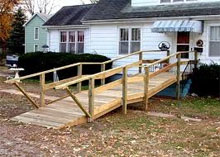
Access Ramps Resources
- Home
- Types of Access Ramps
- Access Ramps for Disabled
- Access Ramps for Sale
- Access Ramps for Wheelchairs
- Ada Access Ramps
- Building Access Ramps
- Disability Access Ramps
- Disabled Access Ramps
- Disabled Access Ramps Regulations
- Easy Access Ramps
- EZ Access Ramps
- FAQs Access Ramps
- Handicap Access Ramps
- Handicapped Access Ramps
- Lightweight Access Ramps
- Modular Access Ramps
- Portable Access Ramps
- Portable Disability Access Ramps
- Vehicle Access Ramps
- Wheelchair Access Ramps
Handicap Access Ramps
Handicap access ramps allow wheelchair users to get access to a building where other more mobile users would use the stairs. Handicap access ramps are not only useful for wheelchair users because they can be used by people pushing baby strollers, carts or bicycles, who can avoid the discomfort and stress of having to lift heavy objects, to gain access to a building. Handicap access ramps are inclined planes that need to be installed in a way that provide easy access, but are not so steep as to cause a risk of loss of control and possibly injury to the user.
Types of access ramps
Handicap access ramps can be either permanent, or semi permanent, or even portable. In the United States, permanent access ramps are required by legislation to be available in public places. They should be designed to be strong, long lasting and are required to be available for use at all times. Permanent access ramps should be cemented or bolted into place, while sometimes wood is used for permanent ramps, steel is a better option, as it will not get slippery when it rains which can be a problem with wooden handicap access ramps.
It is generally agreed that steel ramps have a number of shortcomings for semi permanent handicap access ramps; in particular, they are heavy and difficult to move. As an alternative, aluminum handicap access ramps offer a very suitable solution. Obviously aluminum is not as strong as steel, however aluminum is far lighter to move and extremely strong and resilient, furthermore it will not rust. If the location of the handicap access ramps will be exposed to the elements, durability is important and aluminum is an extremely suitable material.
Advantages of portable access ramps
Portable handicap access ramps are most often made of aluminum; this makes sense from a number of points of view. Portable ramps need to be lightweight and should be able to be easily folded for easy transport. Portable handicap access ramps are normally used in the home or for specially equipped vans designed for mobility access. Portable ramps can be used to transport both wheelchairs on their own and the wheelchair with its occupant on board, easily from the van to the destination or vice versa. Portable handicap access ramps make embarking or disembarking from the van as hassle free as possible for the wheelchair user as well as their caregivers.
Rules and regulations
Handicap access ramps need to be designed and installed carefully, a bad design can be more of a risk to cause injury than a help to handicapped users. In the United States, there are general rules regarding the minimum width and the maximum slopes that are permitted in public places. Individual US states also have their own regulations. If you are going to be responsible for installing handicap access ramps in a public space, make sure you are aware of the local regulations.
While older public buildings in the United States can be exempted from being required to provide handicapped access ramps, for new buildings, this is a mandatory requirement as defined by the Americans with Disabilities Act.